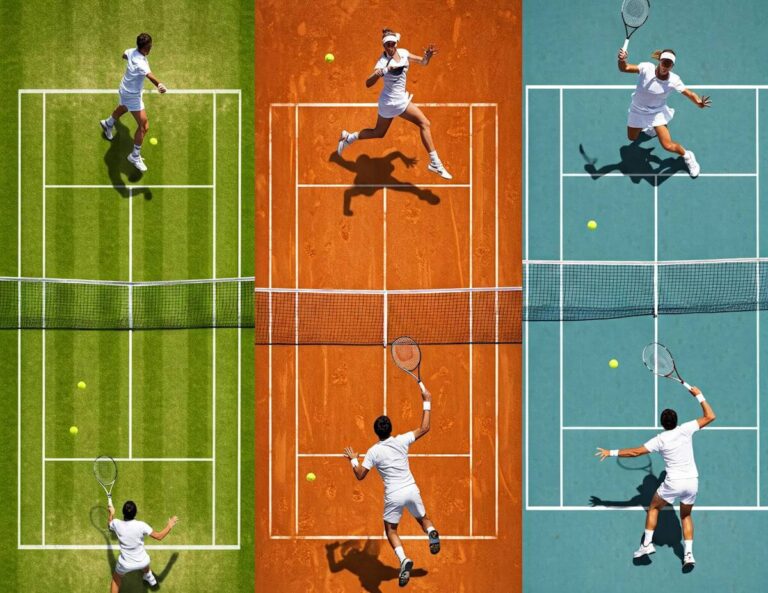Introduction to Tennis Injuries
Tennis, a widely popular sport played both recreationally and professionally, is not only an exhilarating game but also one that poses a risk of injury. The dynamic movements required, such as rapid sprints, abrupt stops, and powerful strokes, can lead to various injuries among players of all skill levels. Common tennis injuries often include sprains, strains, tendinitis, and even fractures, primarily affecting the shoulders, elbows, wrists, knees, and ankles.
Amateur players are particularly susceptible to injuries stemming from a lack of proper warm-up, inadequate technique, and insufficient conditioning. On the other hand, professionals, despite their rigorous training and experience, can face injuries due to high-intensity play and overuse, which may lead to chronic conditions. For example, tennis elbow, medically known as lateral epicondylitis, is prevalent in players who repeatedly engage in backhand strokes without proper technique or fortification of surrounding muscles.
The significance of injury prevention in tennis cannot be overstated. Athletes are encouraged to implement comprehensive warm-up routines, incorporate strength and flexibility training, and employ proper equipment to mitigate injury risk. Furthermore, recognizing the early signs of injury—such as discomfort, swelling, or reduced range of motion—allows players to seek timely treatment and ultimately minimizes long-term consequences.
Ultimately, understanding the common injuries associated with tennis, alongside preventive measures and early intervention strategies, becomes pivotal for players aspiring to maintain their performance and enjoyment of the game. By adopting a proactive approach to injury management, players can significantly reduce the likelihood of injuries and prolong their participation in one of the world’s most beloved sports.
Understanding Common Tennis Injuries
Tennis is a physically demanding sport that, while enjoyable, also poses a risk of various injuries. Among the most prevalent injuries athletes encounter, lateral epicondylitis, commonly known as tennis elbow, stands out. This condition results from the overuse of the forearm muscles and tendons, which can lead to pain and tenderness on the outer elbow. Athletes often experience discomfort when gripping or lifting objects and may have difficulty fully extending the arm. Symptoms typically arise gradually and can significantly impact performance if not addressed.
Another frequent injury is wrist sprains, which occur when excessive force is applied to the wrist, often resulting from a fall or awkward stroke. Symptoms include swelling, pain, and limited range of motion. It’s essential to recognize that untreated wrist sprains can lead to chronic issues, thereby necessitating proper management and rehabilitation.
Shoulder injuries are another significant concern in tennis. This encompasses a range of conditions, from rotator cuff tendinitis to shoulder impingement syndrome. Players who frequently serve or hit overhead shots may encounter these injuries due to repetitive motion, leading to pain localized in the shoulder area and possibly extending down the arm. Symptoms may include weakness, limited mobility, and discomfort during activity. Early recognition and treatment play a crucial role in recovery, allowing players to return to the court more swiftly.
Ankle sprains also feature prominently among common tennis injuries. They result from rolling, twisting, or turning the ankle, often during rapid directional changes. Symptoms typically include swelling, bruising, and severe pain around the ankle joint. Given the unpredictable nature of the sport, it is often challenging to prevent these injuries entirely, but with proper warm-up routines and strength training, players can reduce their risk.
Risk Factors for Tennis Injuries
Tennis is a physically demanding sport that requires agility, strength, and precision, yet it poses considerable risk for injuries. Various factors contribute to an athlete’s susceptibility to injuries, which are vital to comprehend for prevention and treatment purposes. One prominent risk factor is poor technique. Inadequate form or the improper execution of strokes can place undue stress on muscles and joints, leading to common injuries such as tendinitis or strains. Thus, proper coaching and technique drills are essential in minimizing these risks.
Another significant contributor to tennis injuries is improper footwear. Tennis players require shoes that provide adequate support, cushioning, and traction. Worn-out or inappropriate shoes can lead to ankle sprains, plantar fasciitis, and other foot-related injuries. It is crucial for players to invest in high-quality footwear suited for the specific demands of the sport.
Overtraining is another risk factor that often goes unnoticed. Athletes who engage in excessive training without allowing sufficient recovery time may experience fatigue, and lowered performance, which increases the likelihood of injuries. Implementing a balanced training regimen with appropriate rest intervals is necessary for maintaining peak physical condition while minimizing injury risks.
Additionally, a lack of conditioning can also lead to tennis injuries. Developing strength, flexibility, and endurance through a well-structured fitness program can fortify muscles and joints, preparing the body for the physical demands of the game. Age is also a considerable factor; older athletes may be more prone to injuries due to decreased flexibility, strength, and overall physical resilience. Emphasizing regular conditioning and age-appropriate training protocols can help mitigate these risks, allowing players of all ages to enjoy the sport while reducing the likelihood of injuries.
Preventive Measures and Best Practices
Preventing injuries in tennis requires a multifaceted approach that addresses physical preparation, technique, and equipment selection. A well-planned warm-up and cool-down routine form the backbone of any injury prevention strategy. Prior to playing, athletes should engage in dynamic stretching exercises that elevate heart rates and increase blood flow to muscles. This can include light jogging, arm circles, and high knees, which help prepare both the body and mind for the physical demands of the game. After play, a cool-down session consisting of static stretches is crucial for promoting flexibility and reducing muscle soreness.
Strength training plays a vital role in injury prevention as well. A balanced strength training program focusing on core stability, leg strength, and upper body conditioning can enhance an athlete’s overall performance while minimizing the risk of injuries. Exercises such as squats, lunges, and planks can be particularly beneficial. Additionally, incorporating flexibility exercises into a regular training regime will aid in maintaining an optimal range of motion, which is essential for effective movement during matches.
Maintaining good form during play is another critical factor in minimizing the risk of injury. Players should be encouraged to focus on their stance, grip, and swing mechanics, as poor form can lead to excessive strain on muscles and joints. Regular practice with a coach or a more experienced player can facilitate this process, ensuring that proper techniques are consistently applied in competitive scenarios.
Finally, the choice of equipment should not be overlooked. Using a tennis racket that suits one’s playing style and physical attributes, along with appropriate footwear designed for the sport, can significantly reduce the likelihood of injury. Investing in good-quality shoes that provide adequate support and traction contributes to a stable playing environment, which is essential for injury prevention. By diligently applying these preventive measures and best practices, players can enjoy a healthier and more fulfilling tennis experience.
Recognizing the Signs of Injury
In the world of tennis, recognizing the signs of injury is a crucial skill that can significantly influence a player’s health and performance. Understanding the difference between typical fatigue and serious injury can prevent exacerbation of existing conditions and aid in timely recovery. Early detection of symptoms is key to effective treatment.
Common early signs of potential injury include persistent pain or discomfort in specific areas of the body, particularly the shoulders, elbows, wrists, and knees. This discomfort may begin as a mild ache during or after practice sessions but can escalate if ignored. It is vital for players to listen to these signals from their bodies as they often indicate overuse or the onset of a more serious condition. Sharp pain, swelling, or significant changes in range of motion are also critical indicators that warrant immediate attention.
Furthermore, players should pay attention to consistent fatigue. While fatigue is a common experience in demanding sports like tennis, chronic overstress can lead to injuries. If certain movements, such as serving or running, become painful or difficult, it signals the need for a reevaluation of technique or physical condition. In some cases, players may also notice changes in their performance or consistency, which can be early indicators of underlying issues.
It is essential to distinguish between minor discomfort that may subside with rest and serious injuries that require professional assessment. Any recurring ailed sensation should prompt an athlete to consult a healthcare professional. Early action can often save a player from lengthy downtime by allowing for appropriate interventions and rehabilitation strategies. Players must prioritize their health by actively acknowledging and addressing these signs of potential injury.
Immediate First Aid for Tennis Injuries
In the fast-paced world of tennis, injuries can occur suddenly and without warning. When an athlete sustains an injury on the court, immediate first aid is crucial to reduce pain, enhance recovery, and minimize further damage. Among the most effective techniques to address acute tennis injuries is the RICE method, which stands for Rest, Ice, Compression, and Elevation. Implementing this method promptly can significantly impact the healing process.
The first step, Rest, involves ceasing all activity to prevent aggravating the injury. Continuing to play can worsen the condition, leading to longer recovery times. It is vital to listen to one’s body and allow the affected area to recover adequately. The second component, Ice, should be applied to the injured site for about 15-20 minutes every hour. This helps in reducing swelling and alleviating pain. Using an ice pack wrapped in a cloth can provide a soothing effect and minimize the risk of frostbite.
Compression, the third element of the RICE protocol, involves wrapping the injured area with an elastic bandage. This technique helps to control swelling and provides support to the affected muscles and joints. It is essential not to wrap the bandage too tightly, as it may restrict blood flow. Lastly, Elevation involves keeping the injured area raised above heart level whenever possible. This helps reduce swelling and promotes circulation, contributing to a quicker recovery.
Administering these first aid measures immediately after an injury can make a significant difference in an athlete’s journey back to the court. While the RICE method provides an effective initial response, consulting a healthcare professional for a thorough assessment and treatment is vital. Through timely intervention and proper care, players can enhance their chances of a smooth and effective recovery from tennis injuries.
When to Seek Professional Help
Engaging in tennis, like any sport, can lead to injuries that may require professional attention. Recognizing the right time to consult a healthcare provider is crucial for ensuring timely recovery and preventing further complications. There are several key indicators that suggest it may be necessary to seek professional help for a tennis-related injury.
Firstly, if you experience persistent pain that does not subside with rest or over-the-counter pain relievers, it is important to consult a doctor. Pain that escalates during play or everyday activities can signal a more serious issue that needs to be properly evaluated. Additionally, any swelling, bruising, or visible deformity in the affected area should prompt immediate medical attention. These symptoms could indicate sprains, fractures, or strains that require professional diagnosis and treatment.
Furthermore, a limited range of motion that hinders your ability to participate in tennis is another sign to consider seeking professional help. Difficulty moving a joint, such as the shoulder or elbow, can suggest underlying damage that may need physical therapy for recovery. If you find yourself unable to place weight on a limb or experience weakness in any part of your body during gameplay, it is essential to consult a healthcare provider.
In some cases, an athlete may benefit from medical intervention even with minor injuries, particularly if they wish to maintain their performance level. Healthcare providers can offer treatment options, which may include physical therapy, cortisone injections, or in severe cases, surgical intervention to ensure a safe return to the sport. Addressing injuries promptly not only improves recovery but can also enhance overall athletic performance, making it imperative to trust your instincts when it comes to seeking professional advice.
Rehabilitation Techniques for Recovery
Rehabilitation is a vital component in the recovery process after sustaining a tennis injury. A well-structured rehabilitation program focuses on restoring function, strength, and flexibility while minimizing the risk of re-injury. One of the primary methods for recovery is engaging in physical therapy, where specialized therapists design individualized programs tailored to the specific injury and needs of the athlete. These programs typically start with gentle stretching and mobility exercises that help to alleviate pain and promote joint function.
As healing progresses, strengthening exercises become integral to the rehabilitation plan. Resistance bands, light weights, and body-weight exercises can help rebuild muscular strength around the injured area. Notably, developing the core and stabilizing muscles is crucial, as they greatly influence overall performance and support active movements on the court. Given the repetitive nature of tennis, exercises that mimic the sport’s specific movements are particularly beneficial. This sport-specific training aids in a smoother transition back to regular play.
Furthermore, gradually reintroducing tennis-specific activities is essential for a safe return to the game. Athletes should start with low-intensity drills, focusing on proper technique without high stress on the body. It is important to monitor one’s response to these activities, ensuring no pain reoccurs during practice sessions. Alongside physical practices, players should prioritize adequate rest and recovery, incorporating rest days and restorative strategies such as ice application or compression to reduce inflammation. Equally, a focus on nutrition can enhance healing and prepare the body for the demands of playing.
Ultimately, by adhering to a structured rehabilitation plan and actively engaging in preventative strategies, players can return to the court with a reinforced body while significantly decreasing the chance of re-injury. Emphasizing recovery through rehabilitation techniques fosters resilience and longevity in a player’s tennis career.
Conclusion: Embracing a Healthy Playing Lifestyle
In the realm of tennis, the significance of a proactive approach to health and injury prevention cannot be overstated. Tennis players, whether amateur or professional, are frequently at risk of sustaining injuries due to the high-impact nature of the sport. It is essential for athletes to develop a comprehensive understanding of their physical limits and to adopt healthy practices that align with their playing style. Incorporating regular strength and conditioning training, enhancing flexibility through stretching exercises, and successful warm-up routines are foundational elements that contribute to injury prevention.
Moreover, players should prioritize body awareness by recognizing the signs of fatigue and potential overexertion. Being attuned to how one’s body feels during and after play can significantly mitigate injury risks. This understanding can guide players to modify their training loads, ensuring that their physical activities remain within safe limits. Additionally, players should consider sport-specific strategies that focus on optimizing their technique, which can enhance performance while simultaneously reducing strain on muscles and joints.
Nutrition and hydration also play pivotal roles in maintaining health and fitness levels. A well-balanced diet that fuels the body for sustained energy during long matches, alongside proper hydration practices, can significantly impact overall performance and recovery. Furthermore, players can benefit from cross-training activities, which not only enhance physical fitness but also promote a more rounded athletic development—reducing the likelihood of overuse injuries associated with repetitive motions in tennis.
Ultimately, embracing a healthy playing lifestyle in tennis requires commitment to these proactive measures. By fostering awareness, implementing preventive strategies, and nurturing the body, players can enjoy the sport they love while minimizing the setbacks commonly caused by injuries.



